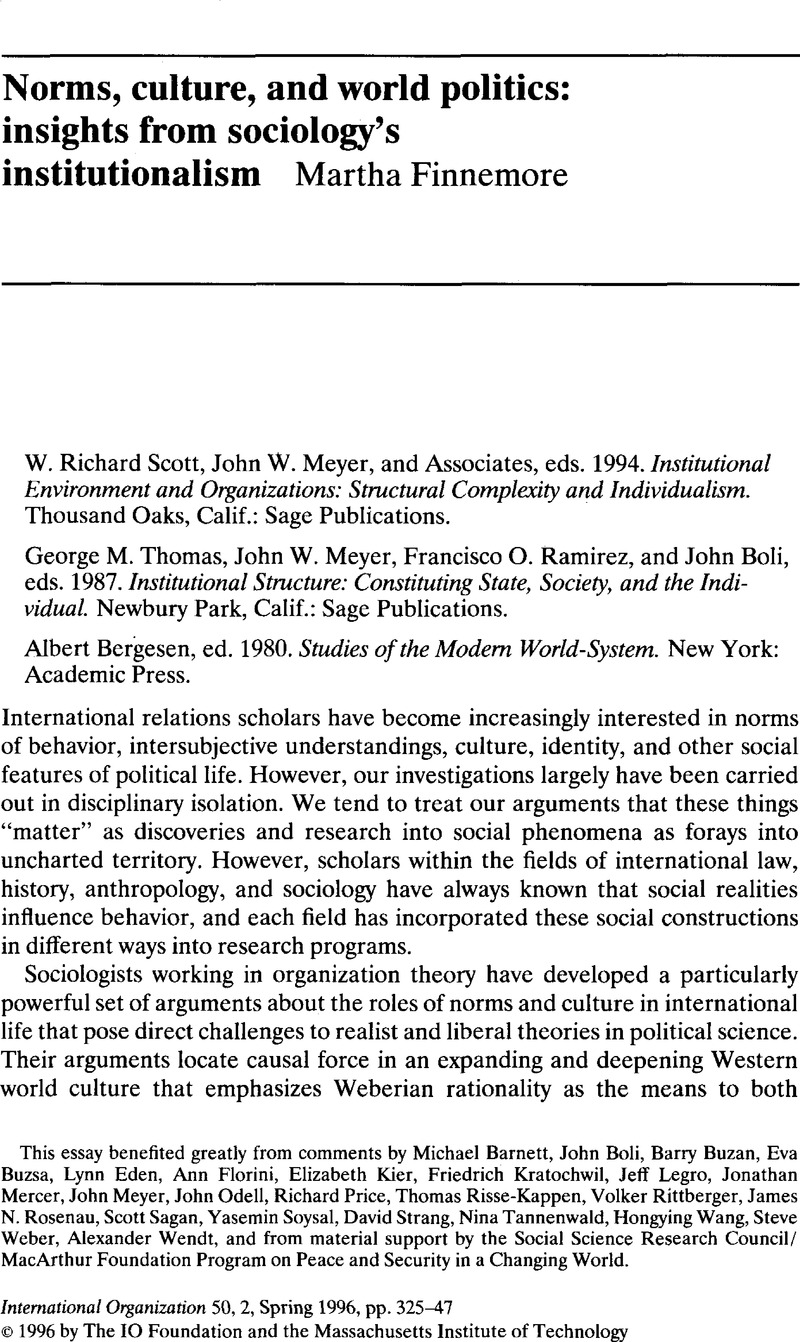Crossref Citations
This article has been cited by the following publications. This list is generated based on data provided by Crossref.
Meyer, John W.
Boli, John
Thomas, George M.
and
Ramirez, Francisco O.
1997.
World Society and the Nation‐State.
American Journal of Sociology,
Vol. 103,
Issue. 1,
p.
144.
Florini, Ann M.
1997.
A new role for transparency.
Contemporary Security Policy,
Vol. 18,
Issue. 2,
p.
51.
WILLIAMS, MICHAEL C.
1997.
The Institutions of Security.
Cooperation and Conflict,
Vol. 32,
Issue. 3,
p.
287.
Marcussen, Martin
1997.
The Politics of Economic and Monetary Union.
p.
76.
CHECKEL, JEFFREY T.
1997.
International Norms and Domestic Politics:.
European Journal of International Relations,
Vol. 3,
Issue. 4,
p.
473.
Sagan, Scott D.
1997.
Why Do States Build Nuclear Weapons? Three Models in Search of a Bomb.
International Security,
Vol. 21,
Issue. 3,
p.
54.
Joppke, Christian
1998.
Why Liberal States Accept Unwanted Immigration.
World Politics,
Vol. 50,
Issue. 2,
p.
266.
Verweij, Marco
Oros, Andrew
and
Jacquin-Berdal, Dominique
1998.
Culture in World Politics.
p.
1.
JACHTENFUCHS, MARKUS
DIEZ, THOMAS
and
JUNG, SABINE
1998.
Which Europe?.
European Journal of International Relations,
Vol. 4,
Issue. 4,
p.
409.
Sikkink, Kathryn
1998.
Transnational Politics, International Relations Theory, and Human Rights.
PS: Political Science & Politics,
Vol. 31,
Issue. 3,
p.
517.
Checkel, Jeffrey T.
1998.
The Constructive Turn in International Relations Theory.
World Politics,
Vol. 50,
Issue. 2,
p.
324.
Sikkink, Kathryn
1998.
Transnational Politics, International Relations Theory, and Human Rights.
PS: Political Science & Politics,
Vol. 31,
Issue. 3,
p.
517.
Jupille, J.
and
Caporaso, J. A.
1999.
INSTITUTIONALISM AND THE EUROPEAN UNION: Beyond International Relations and Comparative Politics.
Annual Review of Political Science,
Vol. 2,
Issue. 1,
p.
429.
Lipson, Michael
1999.
The reincarnation of CoCom: Explaining post‐cold war export controls.
The Nonproliferation Review,
Vol. 6,
Issue. 2,
p.
33.
Leca, Jean
1999.
The Enduring Dialogue of Conflict and Order in a Changing World.
International Political Science Review,
Vol. 20,
Issue. 1,
p.
5.
Gurowitz, Amy
1999.
Mobilizing International Norms: Domestic Actors, Immigrants, and the Japanese State.
World Politics,
Vol. 51,
Issue. 3,
p.
413.
Green, Daniel M.
1999.
The lingering liberal moment: An historical perspective on the global durability of democracy after 1989.
Democratization,
Vol. 6,
Issue. 2,
p.
1.
1999.
Bibliography.
Journal of European Public Policy,
Vol. 6,
Issue. 4,
p.
692.
Kellow, Aynsley
1999.
Australia in the Greenhouse: Science, Norms and Interests in the Kyoto Protocol.
Energy & Environment,
Vol. 10,
Issue. 3,
p.
275.
Clemens, Elisabeth S.
and
Cook, James M.
1999.
POLITICS AND INSTITUTIONALISM: Explaining Durability and Change.
Annual Review of Sociology,
Vol. 25,
Issue. 1,
p.
441.





